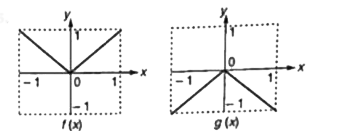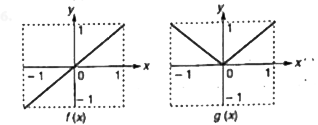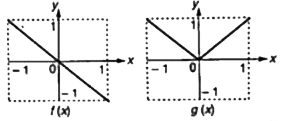In each question there are two graphs f(x) and g(x) for the real values of x.

if g(x)=f(−x)
If g(x)=−f(x)
If g(x)=|f(x)|
If none of the above is true.
The correct Answer is:B
Step by step video, text & image solution for In each question there are two graphs f(x) and g(x) for the real values of x. by Maths experts to help you in doubts & scoring excellent marks in Class 14 exams.
Topper's Solved these Questions
- BOOK - ARIHANT SSCCHAPTER - FUNCTIONS AND GRAPHEXERCISE - Final Round40videos
FUNCTIONS AND GRAPH
- BOOK - ARIHANT SSCCHAPTER - FUNCTIONS AND GRAPHEXERCISE - EXERCISE(LEVEL 1)84videos
FUNCTIONS AND GRAPH
- BOOK - ARIHANT SSCCHAPTER - ELEMENTS OF ALGEBRAEXERCISE - EXERCISE(LEVEL 1)32videos
ELEMENTS OF ALGEBRA
- BOOK - ARIHANT SSCCHAPTER - FUNDAMENTALS EXERCISE - TEST OF YOU - LEARNING - 240videos
FUNDAMENTALS
Similar Questions
Knowledge Check
- Question 1 - Select One
In each of the following questions a pair of graphs f(x) and g(x) is given, defined for every x∈(−1,1). Choose the correct answer as
 AA, if f(x)=−g(x) for every xBB. if f(x)=g(x) for x<0andf(x)=−g(x)x>0CC. if f(x)=−g(x) for x<0andf(x)=g(x),x>0DD. none of these
AA, if f(x)=−g(x) for every xBB. if f(x)=g(x) for x<0andf(x)=−g(x)x>0CC. if f(x)=−g(x) for x<0andf(x)=g(x),x>0DD. none of these - Question 2 - Select One
In each of the following questions a pair of graphs f(x) and g(x) is given, defined for every x∈(−1,1). Choose the correct answer as
 AA. if f(x)=−g(x) for every xBB. if f(x)=g(x) for x<0andf(x)=−g(x)x>0CC. if f(x)=−g(x) for x<0andf(x)=g(x),x>0DD. none of these
AA. if f(x)=−g(x) for every xBB. if f(x)=g(x) for x<0andf(x)=−g(x)x>0CC. if f(x)=−g(x) for x<0andf(x)=g(x),x>0DD. none of these - Question 3 - Select One
In each of the following questions a pair of graphs f(x) and g(x) is given, defined for every x∈(−1,1). Choose the correct answer as
 AA. if f(x)=−g(x) for every xBB. if f(x)=g(x) for x<0andf(x)=−g(x)x>0CC. if f(x)=−g(x) for x<0andf(x)=g(x),x>0DD. none of these
AA. if f(x)=−g(x) for every xBB. if f(x)=g(x) for x<0andf(x)=−g(x)x>0CC. if f(x)=−g(x) for x<0andf(x)=g(x),x>0DD. none of these
If two real functions f and g such that f(x)=x2 and g(x)=[x], then the value of f(−2)+g(−12) is
View SolutionIf f(x)andg(x) are mirror image of each other through y=x and such that f(x)=ex+x then the value of g'(1) is
View SolutionConsider that f:A→B
(i) If f(x) is one-one f(x1)=f(x2)⇔x1=x2 or f'(x)≥0 or f'(x)≤0.
(ii) If f(x) is onto the range of f(x) = B.
(iii) If f(x) and g(x) are inverse of each other then f(g(x)) = g(f(x)) = x.
Now consider the answer of the following questions.
If f(x) and g(x) are mirror image of each other through y = x and such that f(x) =ex+x then the value of g'(1) isView SolutionThe absolute valued function f is defined as f(x)={xx≥0−xx<0} and fractional part function g(x) as g(x) = x-[x], graphically the number of real solution(s) of the equation f(x) = g(x) is obtained by finding the point(s) of interaction of the graph of y = f(x) and y = g(x).
The number of solutions (s) of |x−1|={x},x∈[−1,1] isView SolutionThe absolute valued function f is defined as f(x)={xx≥0−xx<0} and fractional part function g(x) as g(x) = x-[x], graphically the number of real solution(s) of the equation f(x) = g(x) is obtained by finding the point(s) of interaction of the graph of y = f(x) and y = g(x).
The number of solution (s) |x−1|−|x+2|=k, when −3<k<3View Solution



